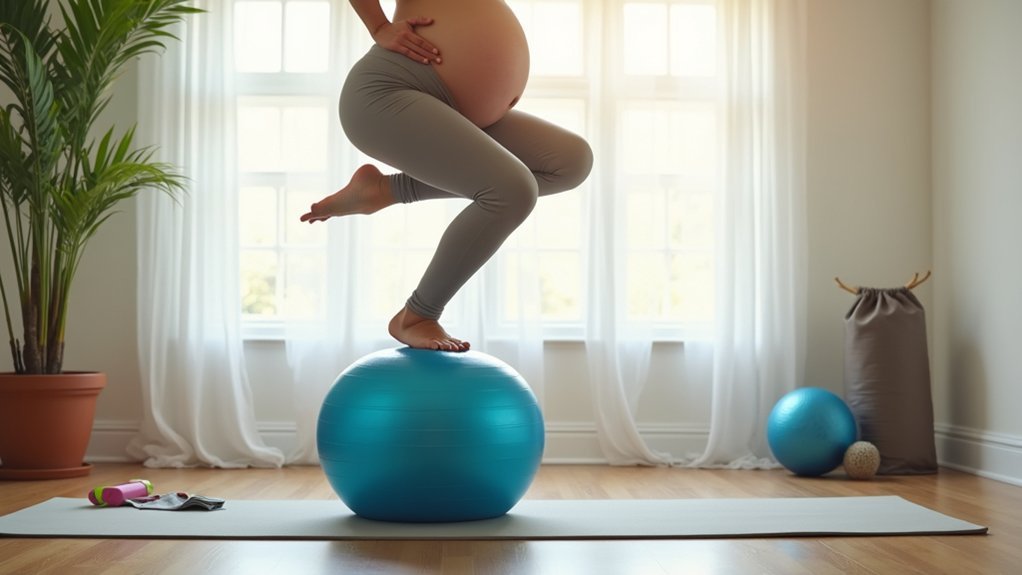For safe pregnancy rebounding, limit continuous jumping to 2-5 minutes with breaks and keep total daily time under 15 minutes. Pre-activate your pelvic floor before bouncing and maintain a heart rate below 140 BPM. Modify movements by trimester—gentle stepping in first, controlled movements in second, and heel lifts in third. Always wear supportive footwear and stop immediately if experiencing pain or dizziness. The right techniques can transform this low-impact exercise into a pregnancy-safe routine.
The Science Behind Low-Impact Rebounding During Pregnancy

While pregnancy often requires modifications to your exercise routine, low-impact rebounding has emerged as a compelling option for expectant mothers. This gentle bouncing workout offers significant biomechanical advantages by reducing joint stress while maintaining cardiovascular fitness.
Research shows rebounding improves dynamic balance through proprioceptive training—crucial as your center of gravity shifts. Your body experiences fewer ground reaction forces compared to running, while still engaging the pelvic floor and supporting core stability. However, it’s important to keep sessions short as part of a circuit training approach to minimize potential pelvic floor strain.
Gentle bouncing enhances proprioception and balance while activating core muscles—essential adaptations during pregnancy’s physical transformations.
The rhythmic vertical movement may enhance lymphatic circulation. Physiologically, rebounding optimizes maternal circulation for better fetal oxygenation, helps manage gestational weight, and reduces pregnancy discomfort.
You’ll benefit from endorphin release and blood pressure regulation through moderate aerobic activity—all without the high-impact strain that could compromise joint stability.
Safe Mini Trampoline Modifications for Each Trimester
As your pregnancy progresses, you’ll need to adapt your mini trampoline workouts to accommodate your changing body.
During the first trimester, focus on maintaining proper posture and reducing jump height, while the second trimester requires more attention to balance techniques and gentle landing methods.
By the third trimester, you should eliminate heavy lifting and jumping entirely to protect your increasingly loosened pelvic floor tissues.
First Trimester Bouncing Basics
During your first trimester, you’ll need to modify your mini trampoline workout to accommodate early pregnancy changes. Eliminate high-impact bouncing completely, replacing jumps with gentle stepping motions, slow marches, or controlled swaying.
Keep sessions brief—just 10-15 minutes—to prevent fatigue and overheating.
Focus on these pregnancy-safe movements:
- Lateral lunges and weight shifts to build stabilizing muscles while maintaining balance
- Gentle arm circles and overhead presses performed while standing steadily on the rebounder
- Controlled stepping patterns that avoid breath-holding or sudden directional changes
Always listen to your body and stop immediately if you experience pelvic pain, dizziness, or cramping. Even though there are no definitive studies, the potential GeForce of 2-6 G’s during rebounding presents unknown risks to your developing baby.
Consult your healthcare provider before beginning any rebounding routine, especially if you have a high-risk pregnancy.
Second Trimester Balance Techniques
Your second trimester brings new balance challenges as your center of gravity shifts with your growing baby. Maintain stability by widening your stance and using the trampoline’s edge for support when needed. Focus on controlled movements with soft knee bends rather than high-impact bouncing. It’s essential to consult with your healthcare provider before continuing or starting any rebounding routine during pregnancy.
| Exercise Type | Technique | Benefits |
|---|---|---|
| Lateral Lunges | Wide stance, gentle side steps | Improves hip mobility while maintaining stability |
| Arm Circles | Feet planted, arms moving | Increases upper body circulation without balance risk |
| Gentle Marching | Controlled knee lifts, no bouncing | Strengthens core while practicing balance |
Limit sessions to 20-30 minutes, breaking into shorter intervals if needed. Remember to strengthen your pelvic floor with Kegel exercises and avoid deep, jerky movements that could strain these muscles.
Third Trimester Safety Adaptations
The third trimester introduces significant physical changes that require careful adaptation of your trampoline workouts. During these final months, prioritize stability and pelvic floor protection by using low-rebound trampolines with handrails and adequate padding to minimize fall risks.
Modify your routine with these key adjustments:
- Limit jumping intervals to just 1-2 minutes per set, incorporating seated alternatives between sets and keeping total workout time under 20 minutes.
- Monitor intensity by maintaining your heart rate below 140 BPM and staying hydrated in cool environments.
- Replace jumps with gentler movements like heel lifts, toe taps, or controlled knee raises to reduce pelvic pressure.
Your center of gravity shifts significantly during the third trimester, which can affect your balance and increase the risk of falls during exercise.
Always stop immediately if you experience bleeding, contractions, or fluid leakage, and verify you’ve received medical clearance from your OB-GYN.
5-Minute Gentle Bouncing Routines for Morning Energy
Start your morning with gentle bouncing on a birthing ball to relieve back pain and improve your circulation during pregnancy.
You’ll notice improved pelvic alignment and muscle tone while keeping your joints safe from high-impact movements.
Begin with just one minute of pelvic rocking before gradually incorporating controlled bounces and hip circles to energize your body safely. Gentle bouncing on the ball engages core muscles while supporting your changing body throughout pregnancy.
Gentle Bouncing Benefits
Gentle bouncing during pregnancy offers numerous benefits that extend beyond simple exercise, making it an excellent addition to your morning routine.
This low-impact movement helps prepare your body for labor by promoting pelvic flexibility while simultaneously relieving back and pelvic pain common during pregnancy. Consistent gentle bouncing can encourage the baby to move into optimal positioning for delivery.
When you incorporate gentle bouncing into your daily life, you’ll experience:
- Improved energy levels – Starting your day with gentle movement combats morning fatigue and enhances your mood
- Better pelvic alignment – Regular bouncing helps position your baby efficiently for birth and may even shorten labor
- Mental relaxation – The rhythmic motion creates a calming effect, reducing anxiety and stress as you begin your day
Remember to maintain proper posture and listen to your body during these exercises.
Pregnancy-Safe Rebounding Techniques
When incorporating rebounding into your pregnancy routine, safety must be your top priority, with proper technique serving as the foundation for these energizing morning workouts.
Always consult your obstetrician before starting, especially if you have a high-risk pregnancy.
Keep your knees softly bent while limiting bounce height to 2-4 inches. Engage your pelvic floor and core muscles throughout each movement, and use handles for stability if needed.
Begin with just 5-10 minute sessions, taking micro-breaks every few minutes to hydrate and assess your comfort. Remember that rebounding offers low-impact exercise benefits while still providing cardiovascular stimulation.
Choose spring-based or bungee-cord rebounders for gentler impact, and always wear supportive footwear.
Stop immediately if you experience dizziness, spotting, contractions, or pelvic pain.
As your pregnancy progresses, consider seated bouncing if standing becomes uncomfortable.
Balancing Techniques for Mini Trampoline Stability

Maintaining proper balance on a mini trampoline becomes especially important during pregnancy as your body undergoes significant changes.
As your center of gravity shifts, you’ll need to adapt your approach to rebounding exercises.
Focus on these key stability techniques:
- Engage your core throughout every movement—this creates a stable foundation while protecting your pelvic floor and lower back.
- Start with smaller movements using light footwork before gradually increasing intensity as you build confidence.
- Use proper equipment, such as a smaller trampoline with safety handles, which provides better control for beginners.
Remember to maintain an upright posture and consider using deep breathing techniques to enhance your focus.
Slow, deliberate movements will help you adjust to your changing body while still enjoying the benefits of rebounding.
During pregnancy, your pelvic floor muscles can weaken due to the additional weight, making proper form crucial when performing rebounding exercises.
Recommended Heart Rate Zones While Rebounding During Pregnancy
When rebounding during pregnancy, you’ll want to monitor your heart rate to stay within a safe zone, typically keeping it below 140-146 BPM depending on your pre-pregnancy fitness level.
Your target heart rate zone may need adjustment as you progress through each trimester, with first trimester workouts potentially allowing more intensity than third trimester sessions.
Rather than focusing solely on numbers, pay attention to how your body feels during exercise, using the “talk test” to verify you’re not overexerting yourself while enjoying the low-impact benefits of rebounding. Modern guidelines from healthcare organizations have moved away from strict heart rate limits and instead emphasize the importance of monitoring your personal comfort level during physical activity.
Heart Rate Monitoring Essentials
How safely can you rebound during pregnancy? Your heart rate serves as a critical safety indicator. ACOG recommends keeping your heart rate below 140 bpm during pregnancy exercise, though this varies based on your fitness level and pregnancy stage.
When rebounding during pregnancy, follow these monitoring essentials:
- Use a heart rate monitor – Continuous monitoring helps you stay within safe zones and detect any abnormalities quickly. Similar to fetal heart monitoring, tracking your own heart rate patterns can help prevent unnecessary complications during exercise.
- Listen to your body – Adjust intensity based on perceived exertion rather than pushing to meet specific heart rate targets.
- Check regularly – Monitor your heart rate before, during, and after rebounding sessions to track patterns and guarantee you’re maintaining safe levels.
Always consult your healthcare provider before starting rebounding exercises during pregnancy.
Trimester-Specific Rate Guidelines
As your pregnancy progresses through each trimester, your heart’s response to exercise changes considerably, requiring adjustments to your rebounding routine.
During your first trimester, expect a modest 3-5% heart rate increase. Keep sessions to 10-15 minutes if you’re new to rebounding, or 20 minutes if previously active.
Focus on how you feel rather than strict BPM limits. It’s important to remember that normal heart rate typically increases by 10-20 beats per minute during pregnancy.
Your second trimester brings a 10-15% heart rate elevation with resting rates around 70-80 BPM. Limit rebounding to 15-20 minutes with rest intervals to accommodate your 30% increased cardiac output.
Pelvic Floor Support During Bounce Exercises

Understanding pelvic floor support during bounce exercises is essential for pregnant women who want to maintain an active lifestyle safely. Before starting any bouncing activity, engage your pelvic floor muscles with a gentle Kegel-like contraction and maintain proper posture to minimize strain.
When performing bounce exercises during pregnancy:
- Pre-activate your pelvic floor by contracting these muscles before you begin bouncing, then coordinate with your breathing (exhale during exertion).
- Limit continuous bouncing to 2-5 minutes with breaks, keeping total daily bounce time under 15 minutes.
- Stop immediately if you experience any urinary leakage, which indicates potential muscle overload.
For ideal support, synchronize your pelvic floor engagement with your transverse abdominal muscles and consider using an exercise ball for lower-impact alternatives. Remember to practice pelvic floor exercises three times daily to maintain strength throughout your pregnancy.
Signs to Stop Your Trampoline Workout Immediately
While trampolines can provide an engaging workout, recognizing when to stop your trampoline exercise during pregnancy is essential for your safety and your baby’s wellbeing.
Stop immediately if you experience sharp abdominal or pelvic pain, vaginal bleeding, or shortness of breath. These symptoms require urgent medical attention.
Also cease activity if you notice persistent dizziness, severe headaches, or balance issues, as hormonal changes affect your stability during pregnancy.
Your body provides clear signals—joint discomfort indicates loosening ligaments that increase injury risk. The American College of Obstetricians and Gynecologists specifically advises against activities with increased fall risk during pregnancy.
Pay attention to any musculoskeletal strain or pelvic floor pressure. If you’re feeling nauseated or unusually fatigued, it’s time to rest.
Partner-Assisted Rebounding for Added Safety
Pregnancy doesn’t necessarily mean giving up your trampoline workouts, especially when you incorporate partner assistance for enhanced safety.
Stay active through pregnancy with partner-supported trampoline workouts that keep you fit while prioritizing safety.
With proper support, you’ll reduce fall risks while enjoying controlled, low-impact movements that protect your changing body.
Before starting, verify you’ve received clearance from your healthcare provider and ideally consult a pelvic floor physiotherapist for technique assessment. Your partner should be trained in prenatal emergency response protocols. Trampolining should be completely avoided as it constitutes high impact exercise that significantly increases risk of injury.
For maximum safety:
- Maintain arm-to-shoulder contact for upper-body stability as your center of gravity shifts.
- Keep sessions short (maximum 5-minute intervals) with seated rest breaks between sets.
- Wear non-slip footwear and supportive compression garments while staying under 140 bpm.
Stop immediately if you experience vaginal pressure or urinary leakage during your session.
Transitioning From Pre-Pregnancy to Pregnancy Bounce Routines
Adjusting from your pre-pregnancy bounce routine requires thoughtful modifications to accommodate your changing body and protect both you and your baby.
First, consult your healthcare provider before continuing any rebounding exercises. Start by reducing workout intensity—convert high-impact jumps to gentler, low-impact movements that minimize joint strain.
Gradually decrease session duration, adding 5-minute increments only when comfortable. Pay attention to your body’s signals; stop immediately if you experience pain or discomfort.
Consider pregnancy-specific routines that emphasize balance and mobility as your center of gravity shifts. Avoid activities with extensive jumping or bouncing as these carry increased risks during pregnancy.
Join prenatal exercise communities for support and tailored guidance.
Post-Workout Recovery Essentials for Pregnant Rebounders
Proper recovery after rebounding exercises becomes even more essential during pregnancy, as your body works doubly hard to support both your workout demands and your growing baby.
Your post-workout routine should prioritize hydration and nutrient replenishment to maintain your energy levels and support fetal development.
Follow these recovery essentials:
- Immediate hydration – Drink water before, during, and after your rebounding session to maintain ideal fluid balance.
- Nutritional timing – Consume a balanced snack with protein and carbohydrates within 30 minutes after exercise.
- Intentional rest – Incorporate gentle stretching and foam rolling, followed by adequate rest periods between workouts.
Pay close attention to any signs of pelvic discomfort during recovery, as these may indicate your jumping exercises are creating too much pressure on your pelvic floor.
Listen to your body’s signals and don’t hesitate to consult your healthcare provider about personalized recovery strategies throughout your pregnancy.
Frequently Asked Questions
Can Rebounding Help With Pregnancy-Related Edema or Water Retention?
Rebounding may help reduce pregnancy-related edema by improving circulation and lymphatic flow. While research is limited, this low-impact exercise could ease fluid retention symptoms. Always consult your healthcare provider before starting any new exercise routine.
Are Certain Trampoline Brands or Models Safer for Pregnant Women?
Low-impact rebounders or mini-trampolines offer the safest options. Look for Springfree’s FlexiNet enclosure, ACON’s reinforced frames, or inground models. You’ll want features like non-slip surfaces and padded edges for stability during pregnancy.
How Do I Properly Measure Rebound Intensity Without Specialized Equipment?
You can measure rebound intensity by monitoring your heart rate, using the talk test, or applying a perceived exertion scale. Count jumps per minute and note how easily you can maintain conversation during exercise.
Will Rebounding Affect My Baby’s Sleep Patterns in Utero?
There’s no direct evidence that rebounding affects your baby’s sleep patterns in utero. While your exercise may improve your overall health, which indirectly benefits your baby, fetal sleep impacts remain largely undocumented.
Can Trampoline Workouts Help Position Baby for Optimal Delivery?
There’s no evidence that trampoline workouts help position your baby for delivery. Instead, try recommended inversion techniques or pelvic rotation exercises that are safer and have more support for improving fetal positioning.
In Summary
Mini trampoline workouts can be a safe, low-impact option during pregnancy when you’re following proper guidelines. Remember to limit your jumps to 1-2 minutes at a time, always listen to your body, and adjust your routine as your pregnancy progresses. With your doctor’s approval, you’ll find rebounding offers unique benefits while keeping you and your baby safe. Don’t forget to stay hydrated and cool throughout your bounce sessions.





Leave a Reply